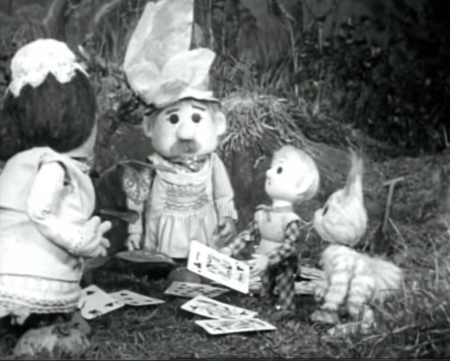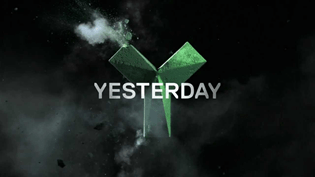Okay girls and boys, gather round. Need your help here. Need your brains. Need your smarts.
You’re clever people. Most of you have got a degree. Many of you have several degrees. And probably a fair few have gone on for the doctorates – which reminds me, that rash at the back of my neck hasn’t cleared up yet so maybe you could take a look at it when we’ve sorted out this vastly more important issue.
Should I spend £50 on a set of DVDs of Pogle’s Wood (1966-1968).
Oh, I hasten to say that it’s not just the 26 quarter-hour editions of Pogle’s Wood, it’s also the six ten-minute instalments of its precursor The Pogles (1965) as well. Don’t know if that makes a difference.
And Pogle’s Wood is a nice place to visit. A lovely place to visit. A rural idyll.
Now, as a wise man once remarked, I bet you’ve never seen a Pogle. And that wise man was Oliver Postgate. And he worked with another wise man called Peter Firmin at their company, Smallfilms. Operating out of a disused cowshed in Kent on next to no money, they and their friends made captivating children’s animations which have endured the decades – notably their two most famous brandings of Clangers (1969-1972, 1974) and Bagpuss (1974).
The word ‘charm’ could have been created especially for the work of Smallfilms – a partnership that gently brought the politics of working co-operatives into the kindergarten. I must check to see if the word ‘charm’ was actually in usage before their first series – Ivor the Engine (1959-1964, 1976-1979) – appeared in 1959. I suspect not. They are captivating. Even Toby – who designs this website so beautifully – was captivated by the Clangers when he met them for the first time last year, and he comes from a non-Smallfilms worshipping country, so they must be good.
Just after New Year, I was fortunate enough to have the rare luxury of one of those browse-through-the-art-books-you-normally-never-get-off-the-shelf afternoons and found myself reading – or rather looking at the pictures of – a particularly lavish tome called the art of Smallfilms (2014) which was edited by the amazing Jonny Trunk of library music fame. He also released the Pogles’ music on CD a few years ago. Smart bloke.
Particularly captivating were all the rich, vivid, warm colours displayed in the photographs of the characters of Pogle’s Wood which appeared in those rather nice photographic storybooks from Hamlyn. I once owned these books because I had been lucky enough to grow up with regular visits to the Pogles at Pogle’s Wood courtesy of BBC Television.
Surrounded by the beauty of the rural English countryside, Mr and Mrs Pogle lived in a hollow tree in a wood with a magic plant. In The Pogles, they rescued a fairy prince from an evil Witch and adopted him as their own. By the time of Pogl’es Wood, the child was their son Pippin, and their rustic household also embraced a strange, striped rabbit-like creature called Tog who spoke in gibberish. Together, the Pogles appreciated the wonders of living in harmony with nature, while the magic plant would weave stories around the things that the inquisitive Pippin and Tog had discovered while out on their adventures.
The original serialised narrative of The Pogles ran as part of BBC1’s afternoon Clapperboard strand, but the self-contained visits to Pogle’s Wood generally took place in the late mornings as part of the Watch With Mother schedule ‘for the very young’. From 1966, the first series cycled around about ten times while the second ran nearer fourteen. That’s until 1973 when people asked why they were paying the extra money for colour licenses when Pippin and Tog were still in shades of grey rather than the rich, vivid, warm colours they were in those rather nice photographic storybooks from Hamlyn.
And – just to confuse things – there were two episodes called Bears in the Wood.
Anyway, between 1966 and 1973, I must have been there to see most of these many broadcasts. They were an important part of my formative years. I have vivid memories of them. The Island of Gamp where umbrellas are grown. The Kings of Hearts, Spades, Diamonds and Clubs who planted a tree that apparently grew a silver apple. The pipe-cleaner family who built things (although, sadly, never a barquentine as far as I remember). The search for a ball – something bouncy, something round, tell us Tog what you have found. I also remember that there’s nothing so nice for Pogles and mice as bread and butter and honey. And that second series climax in which Pippin was brainwashed by the KGB to believe that Mr Pogle had turned traitor and set off to kill him, only to be gunned down by Tog and leaving us not knowing if there would be a third series or not…
Now, my wife and I adore some of the more obscure output of Smallfilms. The Saga of Noggin the Nog (1959-1965, 1982) – concerning the nicest Viking ruler you could wish to meet – is particularly delightful. We’ve been to the Cartoon Museum in London to admire the original art, and we’ve acquired first VHS tapes and then DVDs from the Dragons’ Friendly Society, of which Noggin’s friend, Grolliffe the ice dragon, was treasurer.

Fig 3: “In the Lands of the North, where the black rocks stand guard against the cold sea, in the dark night that is very long, the men of the North Lands sit by their great log fires and they tell a tale. They tell of Noggin, Prince of the Nogs…”
Oh yes, the Dragons’ Friendly Society. It’s now run by Loaf. In Liverpool. You send Loaf some money at The Dragons’ Friendly Society, Liverpool, L18 9UR, and they send you back amazing books and DVDs of all the more obscure Smallfilm brandings that the major players can’t turn a decent profit on.
Some years back we acquired a selection of episodes on chunky old VHS tapes. And now, for £50, I can get a package with all of The Pogles and Pogle’s Wood on lovely digital discs.
But £50? Is it worth it?
And I don’t mean ‘Is it worth it?’ as in suggesting that this product will lack quality. Of course it won’t. The DFS merchandise is wonderful – crafted with care and love. These will be beautiful transfers of the film prints, not nth generation video recordings where n is an integer far greater than one. The packaging itself will be infused with the charm of the original programmes.
Yes – okay, you need more context. Need the facts. Need the info.
Yes, we can afford £50. I may be semi-retired and on a lower income than I used to be in the world of IT, but a set of digitally versatile discs packed with Pogles would not take the place of shelter, warmth, food or water for the next month. We are not – yet – that obsessive in prioritising television above life’s necessities. But bless you for checking.
More context – this is not work. It is not research for an article to go into some lovely periodical like TV Years. The cost will not be covered by a remuneration. This is me wanting to buy something with my money to watch for my own pleasure.
Even more context – my wife and I do not have vast incomes, but we will occasionally save up the spare pennies and treat ourselves to special, wonderful TV-related items. Not limited-edition models or original props from our favourite shows – just nice special odds and ends that mean something to us. Many being rare and exotic imports. Dennis W Nicholson’s extensively illustrated 1994 The Gerry Anderson Memorabilia Guide. Mark Dawidziak’s wonderful assembly of Richard Mathieson’s scripts for the TV movies that begat kolchak: the night stalker (1974-1975). La La Land Records sumptuous 15 CD boxed set of every piece of music ever recorded for Star Trek (1966-1969). Richard Marson’s amazingly researched and presented hardback tome on Upstairs, Downstairs (1971-1975) published by Kaleidoscope. James Eatock’s vast 590-page complete guide to the classic animated adventures of He-Man and the Masters of the Universe (1983-1985), She-Ra: Princess of Power (1985-1986) and all their chums. Objects of celebratory beauty like this that we return to and cherish across the years.

Fig. 4: We had to save our pennies… but it was well worth it in the end. You know how much we love our soundtracks.
In some respects – because I’m from the twentieth century – £50 still strikes me as A Lot Of Money. Values get all distorted with time – they’re index linked to how much you paid for the commodity originally. Thus, simultaneously, I know that my paperback TV tie-in for Timeslip (1970-1971) should set me back only 4/- while I’ll need to pay £19.99 if I want a blank 195-minute Sony L-750 Betamax tape on which to record The Hitch Hikers Guide to the Galaxy (1981) when it makes its debut on BBC2.
So, yes, we are fortunate enough to have £50 to spare and what the Dragons’ Friendly Society has on offer is worth £50.
But is what I’m trying to buy for £50 just a set of The Pogles and Pogle’s Wood? You see, I have a horrible feeling that what I’d really like for my £50 along with a set of The Pogles and Pogle’s Wood is double bills at the cinema complete with a Pink Panther cartoon, a meringue with tea during a visit to Miss Herring’s, a trip to the toy shop half-way along the arcade, and searching for four-leaf clovers on the lawn on that sunny afternoon in 1968 that seemed it would never end during my fortunately safe Middle-Class childhood… and I don’t honestly think that my £50 will cover all that.
And I’m not sure that it’s healthy either. I write about archival television and I do love it so much – that discovery of a programme from an earlier epoch that still entertains and excites decades later. At the moment, I’m talking to a lot of people who feel safer in the past and are scurrying back there as quickly as possible… often to relive the TV schedules of their childhoods. A more secure time – free from mortgages, free from redundancies, free from pandemics. It’s only natural to seek sanctuary. And so the arena of archival television research offers more and more material fuelled by nostalgia and retro imagery. Articles in which being told that the Saint was played by Roger Moore and drove a Volvo will suffice to give you that little safe place in your heart for a few minutes. That’s fine and they have a use… but they’re not what I’m really after.
My work is not about looking at things which are old simply because they are old and even less so that they have a connection with my own experiences – it’s about understanding them or learning about them. Furthermore, my wife and I are not trapped in the past. We know that television is basically as good/bad now as it’s always been. We make a point of trying new shows which may delight as much as the old favourites. 2021 has thus far allowed us to experience The Serpent, The Great British Dig, The New Legends of Monkey, The Mallorca Files, Crackerjack! [i], The Great, It’s a Sin, Finding Alice, The Investigation, Death in Paradise, Joanna Lumley’s Home Sweet Home and even ITV’s revival of Telly Addicts in the form of Paul Sinha’s TV Showdown (which sadly went down the celeb route rather than having hard-core TV devotees as contestants). Some we stick with – some we don’t. But we give them a go. Because we like to try new stuff.
Like Pogle’s Wood, the past is a nice place to visit. A wonderful, engaging place to visit. But I’m not sure that I’d want to live there on a permanent basis.
So – come on then people? Thinking caps on! Do I spend my £50 or not?
Andrew Pixley is a retired data developer. For the last 30 years he’s written about almost anything to do with television if people will pay him – and occasionally when they won’t. Oh, and, in the time you’ve been reading this, his wife’s told him that he can have a set for his birthday and she’ll order it this afternoon. So… that’s all right then.
Footnote
[i] CRACK-ER-JACK! You must be getting so fed up with this now.







These are expensive! When Oliver, Peter and I started up many years ago making VHS tapes, the dilemma facing a small publisher operating from a spare bedroom was that in order to get the cost per unit as low as possible, you had to produce thousands of the buggers, store them… and then what we learned was that shops take 50% of the retail price, and that Pogles don’t fly off shelves without marketing, and of course we did all this, alongside the new fangled Internet, which Oliver and I embraced but Peter Firmin resisted for many years.
Search engines and chat rooms were saviours of the niche.. but our prices were also trying to be fair to the BBC shops and others. Pogles, bless them, didn’t last long with HMV and the likes of WH Smith, shelf space had to be accounted for and justify itself.
Mail order clearly the way forward, the move to DVDs was next, and we kept the prices the same to recoup some of the costs, also although Oliver had supplied the master tape for the first Pogles’ Wood from a BBC VHS compilation (with annoying titles) we had to go back to the film cans for the rest, which was great, but cost a bit, and we did in stages. The next lot were Pogle’s Choice, chosen by Oliver Pogle himself.
Then when we had pored through the scripts Oliver proclaimed ‘STOP’, so we did. He didn’t rate Series One of Pogles Wood very highly, I think disappointed at the loss of the witch, he dismissed them as ‘stocking fillers’ and when collectors demanded them, he told them to ‘bugger off’, usually via me.
After Oliver died we did publish all the remaining films, from both the 16 mm films in Peter’s shed and the BBC Archive, had a sort of kickstarter launch party in Peter’s barn, and I’m proud to say that Oliver was wrong. We hadn’t seen these gems in a lifetime, and they are beautiful.
By this point selling things cheaply started to feel wrong, so we kept going. Now that DVDs are collectors items in the landscape of streaming, there seems no future in them, but while we can, we continue.
If anybody is short of money a lot of the episodes are on YouTube. I felt that it wasn’t nice to spend time and resources trying to stop people sharing things… Counterfeit DVDs are a bit mean, as I have worked hard, as a fan and friend to Oliver and Peter Firmin and Dan Postgate to keep the little publishing thing they trusted me with alive, and in return, I am grateful.
Bless you loaf. Expensive? Possibly. Worthwhile? Definitely!
I like to support specialist DVD releases of rare and obscure shows whenever I can and delight in ventures like this. There’s another blog I did here – “But What I Don’t Understand Is This…” which covered some other examples. Can’t post a link, but it’s here: cstonline.net//cstonline.net///what-i-dont-understand-is-this-by-andrew-pixley/
And, yes, physical media is now a serious collectors’ item. There was a superb article about the notion of it being the new vinyl recently: “Are We Living In A Golden Age Of Archive Television?” by Issy Flower. Check it out – it’s brilliant. Similarly, wish I could post a link, but it lives here: cstonline.net//cstonline.net//www.indiependent.co.uk/are-we-living-in-a-golden-age-of-archive-television/
Thank you for all the lovely things we;ve got from the DFS across the years. Long may you continue to fill the world with Smallfilmy goodness.
Deeply appreciative of your work.
Andrew
And, of course, having said that it *won’t* let me post a link, that’s precisely what it has now done….
Isn’t technology wonderful? Hyperlinks on blogs *and* DVDs of “Pogle’s Wood”!
All the best
Andrew
Oh…. And just for the record, there is only one Bears in the Wood. The other is a mistake 🙂
Ah-ha! Did suspect this was wrong! Thanks for confirming! 🙂
All the best
Andrew
Okay, so, just returned from two days wandering around Pogle’s Wood and I can affirm that this was money well spent! It’s *not* just heady nostalgia. My wife, who never saw these shows at the time, also found these utterkly captivating.
The shows work on so many levels. Some of it is to do with understanding rural life and technology in the mid-1960s. Is that really the kind of equipment we were still using to acquire mile from cows? Is that what earth-movers looked like?
The photography is amazing. Much of it – in the earlier editions – is also rather unsettling and edgy. Which we weren’t expecting…
What really knocked us out through was the vast amount of the earlier shows which was *animated on location!* I mean, how long did that take? It’s utterly astounding.
Most of the episodes are *really* nice, crisp transfers. Yes – this is very specialist material and it’s a delight to see it presented in this manner.
All the best
Andrew
PS: Oddly, the episode about the KGB brainwashing that I remember *wasn’t* there. I suspect I got the plot confused with another series from around the same time. Probably “The Flowerpot Men”…
I’m glad you bought it. It’s how I felt paying a premium price for the out of print The Double Deckers. was gaga for the show as a kid and the trip down memory lance was priceless!
Excellent! Sounds like you paid the right price and, in return, you got what you were after. And I think more and more that knowing what we can reasonably expect is increasingly important. 🙂
All the best
Andrew